Homeowners today live in an era where their houses are highly influenced and dominated by technology. There are so many more appliances and gadgets today that they can use to be more efficient with household management tasks. Such equipment also provides comfort and convenience for the homeowners and anyone who comes to visit them.
But those benefits come with a price. If you aren’t careful, your appliances may lead to a spike your energy usage to the point that you end up spending more for your utilities than what you initially planned and budgeted for. If this has happened or is happening to you, then that’s probably the reason you’re here looking for ways to address the issue.
With that said, here are six tips and tricks you can try in order to have a more energy-efficient home:
1. Replace The Air Filters
Two of the appliances in your home that consume the most energy are your air conditioner and your heater. But as much as you may want to forego using these, they’re needed to keep the temperature inside your home at an optimal level.
Your air conditioner and heater have to be maintained by experts from a trusted heating, ventilation, and air conditioning (HVAC) company such as Global Heating and Air Conditioning for them to function efficiently. The maintenance would involve replacing the air filters. If those are incredibly dirty, the air conditioner and heater would have to use more energy to be able to keep up with your needs.
2. Use Energy-Efficient Bulbs
If you haven’t already made the switch, one of the simplest but most impactful ways to have an energy-efficient home is to replace your current light bulbs w LED ones. These are practically everywhere these days, so not purchasing them means you’re missing out on all the benefits of these bulbs, such as the following:
- They last longer, so you won’t have to replace them as frequently.
- They’re quiet, so you won’t have to worry about humming sounds or any sort of noise coming from them.
- They’re safer as only little energy is lost to heat, which makes them cooler, temperature-wise.
3. Lower Your Thermostat
When you’re using your air conditioner or heater, you’ll naturally want to keep it in the right temperature to keep you comfortable when you’re at home and in the room where that appliance is. But, whenever you’re out, there’s no need to keep the thermostat on too high. Adopt the habit of adjusting the temperature every time you leave the house.

Think of all the cost savings you can have during those hours when you aren’t inside your home. When they eventually add up, you’ll begin to notice a difference in your energy consumption every month.
4. Seal All Windows
How long has it been since you last had your windows checked? Perhaps you may not be aware of the gaps or holes they already have. Such issues would make it difficult for you to close your windows properly.
It’s a good idea to consider weatherstripping around your window’s frames. This can help trap air inside your home so you aren’t wasting all the efforts of your air conditioner or heater.
5. Do Full Loads
If you use a dishwasher and a washing machine at home, never run them half full. You’re wasting so much energy when you aren’t maximizing your dishwasher and washing machine’s capacity. Before using those machines, see to it that you’ll be doing a full load.
This entails good scheduling and doing laundry only on those days when you’ve accumulated enough clothes. As for the dishwasher, the best schedule that would allow you to prevent dishes from piling up is to run a load in the morning and another at night as you tidy up the kitchen after breakfast and dinner, respectively.
6. Unplug Unused Appliances
Appliances that remain plugged but aren’t being used are called ‘energy vampires.’ One cellphone charger may not make a big impact in reducing your energy consumption, but you have to consider all the other appliances in your home that are plugged but idle. You’ll notice a significant reduction in your electricity bill and energy consumption when you make it a point to unplug appliances whenever you don’t need them.
Conclusion
Now that you’re equipped with the tips and tricks above, all that’s left for you to do is to start applying them in your home. Once you do so, you aren’t just lowering your utility costs but also starting to live an eco-friendlier lifestyle. As you can see, working toward an energy-efficient home doesn’t have to come at the expense of your comfort—you can have a perfect balance of both if you know the right steps to take.

